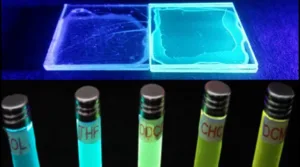Researchers from the Technical University in Dresden (Dresden, Germany) have developed a new method to produce polymer Thermally Activated Delayed Fluorescence (TADF) emitting molecules. The new materials exhibit quantum yields substantially higher than previous such materials.
First, a few words of background information. TADF materials represent an alternative to phosphorescence emitting molecules. Up until now, most of the materials reported to show efficient TADF are based on small molecules. Reports of polymers that support TADF have been infrequent and have shown relatively little improvement in relevant material properties. These reports tend to discuss polymers that are built up from monomeric units that show promising TADF properties in previous small molecule studies. Quite often, the TADF chromophores are linked to a polymer network, thus the chromophores have basically retained their monomeric properties.
Polymeric Emitters
A team of researchers from the Technical University in Dresden, Germany, led by Prof. B. Voit and Prof. S. Rieneke have undertaken research to further investigate polymeric TADF emitters. A recent article published by the team is entitled “Conjugation-Induced Thermally Activated Delayed Fluorescence (TADF): From Conventional Non-TADF Units to TADF-Active Polymers.” It was published in Advanced Functional Materials, Volume 27, Issue 7, February 17, 2017. A copy of the article is available for purchase here.
In this article, the researchers report on a different approach to creating a TADF polymer. More specifically, it is a conjugation‐induced TADF concept in which the materials are solution processable.
“By introducing a controlled extension of the conjugation of the monomers HOMO wave function, the authors observed a destabilization of the latter, which lead to a decreased singlet-triplet splitting and, ultimately, efficient TADF in the polymer. The monomer unit, or the individual repeating unit in the polymer, on the contrary is a poor emitter having inefficient phosphorescence as primary emission channel. As a result, a transition of the photoluminescence quantum yield from about 3% (monomer and model compound for repeating unit) to about 71% (polymer) was observed.”
This result is surprising not only for the high TADF quantum yield achieved in a polymer material but for the fact that the monomer building blocks themselves do not show TADF but, rather, only phosphorescence. The TADF property is induced as a consequence of increased conjugation during polymer formation.
An illustration of the some materials discussed in the technical article are presented in the figure below.
The technical article goes on to provide detailed information on the synthesis of the monomer and polymer materials, quantum chemical calculations and a detailed photo-physical characterization.
The researchers say that, for the first time, “an encouraging method is provided for producing highly efficient TADF oligomers and polymers from solely non-TADF units via induced conjugation, opening a new design strategy exclusive for polymers.” -Arthur Berman
Technical University in Dresden, Prof. B. Voit, [email protected]

